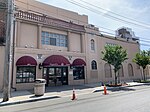Coney Island Creek
AC with 0 elementsBodies of water of BrooklynBrighton BeachConey IslandInlets of New York (state) ... and 1 more
Use mdy dates from September 2019

Coney Island Creek is a 1.8-mile-long (2.9 km) tidal inlet in Brooklyn, New York City. It used to be a 3-mile-long (4.8 km) continual strait and a partial mudflat connecting Gravesend Bay and Sheepshead Bay, making Coney Island an actual island, but the eastern half of the creek was filled in by land owners and city construction projects during a period spanning the early to mid 20th century.
Excerpt from the Wikipedia article Coney Island Creek (License: CC BY-SA 3.0, Authors, Images).Coney Island Creek
Neptune Avenue, New York Brooklyn
Geographical coordinates (GPS) Address Nearby Places Show on map
Geographical coordinates (GPS)
| Latitude | Longitude |
|---|---|
| N 40.579166666667 ° | E -73.988888888889 ° |
Address
Neptune Avenue 2110
11224 New York, Brooklyn
New York, United States
Open on Google Maps









